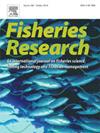渔业依赖和独立的数据提供了一种捕获技术,用于在密西西比河主干线捕获一种新出现的入侵鱼类;青鱼,青鱼
IF 2.2
2区 农林科学
Q2 FISHERIES
引用次数: 0
摘要
青鱼mylophyngodon piceus在20世纪70年代和80年代进口到美国用于水产养殖;逃跑事件时有发生,报告的野生捕获事件也有所增加。由于缺乏特定物种的捕捞方法,我们通过核密度分析评估了一种常见方法——环网法的渔业附带捕捞量,以确定报告增加的区域,并比较水温、河段和捕捞日期的报告频率,以确定季节性。然后,我们利用渔业独立的努力,通过非度量的多维尺度来确定物种的共发生,并通过广义线性模型拟合黑鱼捕捞量和环境协变量,以评估促进捕捞的特定地点环境协变量。对最佳近似分布进行了调整,以进行预测和推理。主要在7 - 9月,在密苏里河和密西西比河的汇合处,渔场依赖环网捕捞的密度最大(39% %)。捕获的平均水温为26.7°C,河流水位为5.02 m,一年223天(DOY;8月中旬)。渔业独立捕捞量排序鉴定了小嘴水牛和黑鲤在环境协变量上的相似性。捕获≥ 1黑鱼的概率随深度增大而增大,随流速增大而减小,随深度增大而增大。大多数捕获发生在外部弯道(87 %)或侧通道(12 %)。捕获黑鱼的可能性较低,但在夏季和初秋阶段较低时增加,这有利于降低流速和进入较深的区域。结果可能会在该河段以外得到验证,以测试特定地点的水文或栖息地特征是否有助于增加商业和生物学家的捕获和复制。本文章由计算机程序翻译,如有差异,请以英文原文为准。
Fisheries dependent and independent data inform a capture technique for an emerging invasive fish species in the mainstem Mississippi River; Black Carp Mylopharyngodon piceus
Black Carp Mylopharyngodon piceus were imported into the United States in the 1970s and 1980s for use in aquaculture; escape occurred and reported wild captures increased. Lacking species-specific capture methods, we assessed fisheries dependent incidental Black Carp catches for a common method, hoop nets, by kernel density analysis to identify an area of increased reporting and compare frequency of reports for water temperature, river stage, and capture date to identify seasonality. We then used fisheries independent effort to identify co-occurrence of species via non-metric multi-dimensional scaling and fit Black Carp catch and environmental covariates by generalized linear models to assess site-specific environmental covariates facilitating capture. The best approximating distribution was refitted for predictions and inference. The greatest density of fisheries dependent hoop net captures (39 %) was near the confluence of the Missouri and Mississippi rivers, primarily from July-September. Captures were characterized by median water temperature 26.7°C, river stage 5.02 m, and 223 day-of-year (DOY; mid-August). Ordination of fisheries independent catch identified similarity in environmental covariates of Smallmouth Buffalo Ictiobus bubalus and Black Carp. The probability of capturing ≥ 1 Black Carp increased with DOY, decreased with increasing current velocity, and increased with depth. Most captures occurred in outside bends (87 %) or side channels (12 %). Probability of Black Carp capture was low but increased in summer and early fall when stage is lower, facilitating reduced current velocity and access to deeper areas. Results may be validated beyond this river segment to test if site-specific hydrology or habitat characteristics facilitated increased commercial and biologist capture and for replication.
求助全文
通过发布文献求助,成功后即可免费获取论文全文。
去求助
来源期刊

Fisheries Research
农林科学-渔业
CiteScore
4.50
自引率
16.70%
发文量
294
审稿时长
15 weeks
期刊介绍:
This journal provides an international forum for the publication of papers in the areas of fisheries science, fishing technology, fisheries management and relevant socio-economics. The scope covers fisheries in salt, brackish and freshwater systems, and all aspects of associated ecology, environmental aspects of fisheries, and economics. Both theoretical and practical papers are acceptable, including laboratory and field experimental studies relevant to fisheries. Papers on the conservation of exploitable living resources are welcome. Review and Viewpoint articles are also published. As the specified areas inevitably impinge on and interrelate with each other, the approach of the journal is multidisciplinary, and authors are encouraged to emphasise the relevance of their own work to that of other disciplines. The journal is intended for fisheries scientists, biological oceanographers, gear technologists, economists, managers, administrators, policy makers and legislators.
 求助内容:
求助内容: 应助结果提醒方式:
应助结果提醒方式:


